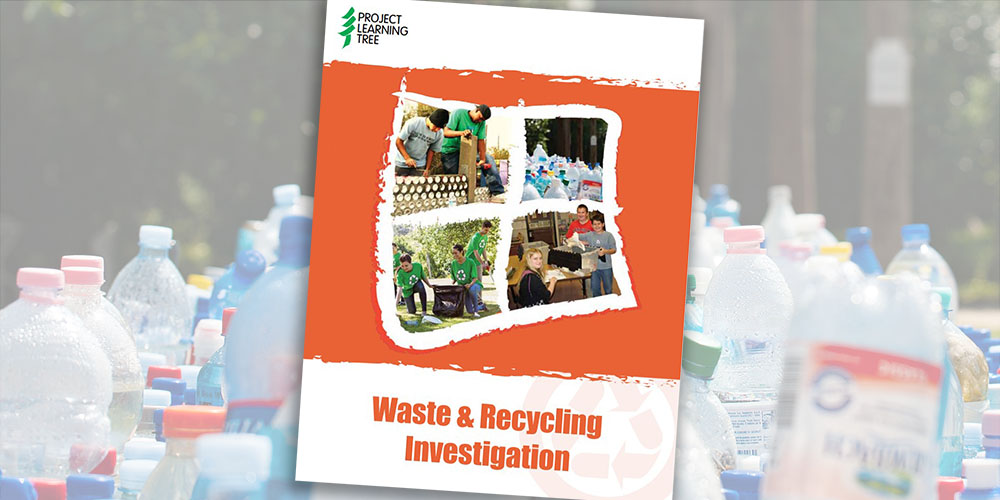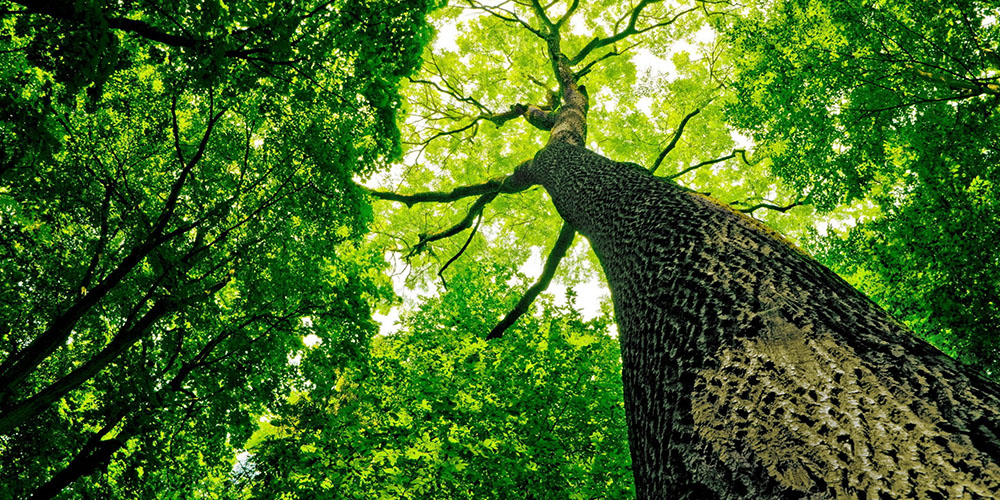Waste & Recycling Investigation
Investigate Waste & Recycling
Our fast-paced society is full of items to make our lives more convenient – from fast-food wrappers and cups to disposable bags. But these convenience items, as well as other disposable items we use, can end up in landfills. It costs money to dispose of them and creates environmental problems.
Project Learning Tree’s Waste & Recycling Investigation is one of five hands-on, student-driven investigations at the heart of PLT’s GreenSchools program where students investigate how much waste their school generates and where it goes, as well as recycling and composting efforts. The Investigation details specific things for students to measure and observe, along with student worksheets to fill out and guidance on how to combine data collected into a school-wide analysis.
PLT’s GreenSchools program inspires students to improve the environment at their school, at home, and in their community. Student-led Green Teams apply STEM (science, technology, engineering, math) to create greener and healthier schools—and save schools money!
In the Waste & Recycling Investigation, students collect data on their school’s waste stream, including recycling, composting, and waste removal. Using the data collected from the Investigation, students can develop action projects to reduce waste and natural resources use.
Examples of Students’ Action Plans
Students compost cafeteria waste and cut down on disposables. They recycle batteries, milk containers, plastic bags, and other items. They educate others at school and in their community about reducing waste, for example, cutting down on single use plastics.
Get all five GreenSchools Investigations here which includes:
- Adult Leader Guide – Information on the benefits of becoming a green school, who to involve, how to form a Green Team, the steps to take to support students in conducting the Investigations, STEM connections and suggestions for additional activities to enhance each Investigation topic.
- Energy Investigation – Students investigate how much energy their school uses, the main sources of that energy, and ways to implement energy-saving strategies.
- Environmental Quality Investigation – Students investigate areas where improvements can be made in indoor air quality, transportation, chemical use, and more.
- School Site Investigation – Students investigate natural habitats, wildlife, trees, grounds maintenance practices, and ways to make improvements to their school site.
- Waste & Recycling Investigation – Students investigate how much waste their school generates and where it goes, as well as recycling and composting efforts.
- Water Investigation – Students investigate the source, cost, and quality of their school’s water supply, and ways to enhance current water conservation practices.
Testimonials
“The investigations led students to recognize the need for reducing campus waste and replanting the beds in front of the school with drought-tolerant native plants. Using these findings, they conducted a campus-wide educational campaign and constructed composting bins to reduce waste.” – Jane Smith, School Counselor, Joan MacQueen Middle School, Alpine, CA
“Our seventh-graders have accomplished great things since we started with the PLT GreenSchools program. We’ve made major strides in making our school greener using activities from the School Site, Energy, and Waste and Recycling Investigations. Thanks to their efforts, we are now the number one school in our district for energy conservation.” – Jill Henrie, Neil Richards, and Kelly Flindt, 7th grade science teachers, Owasso Seventh Grade Center, Owasso, OK
“PLT’s GreenSchools gives the school tools to make decisions, and gives kids a sense of purpose and worthwhile achievement.” – Sandy Gresham, Science Teacher, Lowcountry Preparatory School, Pawleys Island, SC
EE Resources
Challenge Your Eco-Footprint
BillerudKorsnäs, a renewable packaging material organization that specializes in creating sustainable packaging solutions, created this interactive resource titled Challenge your eco-footprint. It helps people understand the differences between types of waste and recyclable materials and how long they remain in the environment. Displayed in the resource is a digital representation of how long it takes for... Read more »
Imagine If
Imagine If is a podcast on climate resilience. Developed by the National Association for Environmental Education and National Geographic, Imagine If interviews change-makers affecting positive change on the world. Imagine If features high school students designing solutions to environmental issues in their communities. Listen with your students and inspire them to become change-makers in their community!
A Guide to Setting up a Simple Backyard Compost System
Composting is easy, especially if you are already working with your students on a school garden. A Guide to Setting up a Simple Backyard Compost System explains where to place it, what you can and can’t put in it, and the necessary steps you need to take to be successful to create “black gold.”
30 Day Zero Waste Challenge!
Be Zero inspires, educates, and activates others to reduce their plastic and trash footprint for a sustainable future. Join the challenge with your students too! For example, one article on their blog called How to Pack a Zero Waste Kids Lunch highlights how one parent used a bento style stainless steel container called PlanetBox to... Read more »
Eco-Friendly Guide to Cleaning
Did you know that indoor air can be up to 100 times more polluted than outside air due to the accumulation of volatile organic compound (VOC) levels caused by chemical cleaning agents? Have students investigate the impact of common cleaning products on their environment, learn about “green cleaning,” and how to create their very own... Read more »
Pack a Waste-Free Lunch
Learn how to be waste-free! EPA developed these Waste-Free Lunch activities to help students learn how to reduce, reuse, and recycle items in their school lunches. Included are tips for packing a waste-free lunch and a healthy lunch menu worksheet.
Funding for Greener Schools
Have you thought about trying crowdfunding to help get a GreenSchools project off the ground? Or reaching out to your community to find advocates and volunteers? The ioby (in our back yards) crowd-resourcing platform can connect you with funding and support. Whether it’s updating your school garden, adding a cafeteria composting program, or teaching students... Read more »
Sustainability in Schools Simulation Game
Looking for ways to bring sustainability projects to your school? Use the Sustainability in Schools Game with your middle and high school students to explore the cost-benefits. The game includes 45 cards covering a range of sustainability projects that could be implemented in your own school, along with video instructions and critical thinking questions to get your... Read more »
Think Green Infographic
Produced by the EPA, this Think Green Infographic is a great way to get your students thinking through simple, thought-provoking questions – Do You Really Need It?, How “Green” Is It?, Can You Reuse It?, and Can You Buy It Used? The graphic provides tips and action steps middle and high schoolers can take to reduce their... Read more »
Where Does Our Trash Go?
The lifecycle of garbage is illustrated through photos and simple captions from the Lawrence County Solid Waste Management District (IN).
Municipal Solid Waste
This U.S. EPA website provides in-depth information on solid waste generation, recycling, and disposal in the United States.
Waste-Free Lunches
This website provides information on developing and implementing a waste-free lunch program at schools. It includes tips, success stories, and resources.
Keep America Beautiful
Keep America Beautiful is a nonprofit that provides waste education materials, events, and programs.
How Green Is My Town?
This award-winning environmental assessment program is designed to help local governments address issues of climate change, sustainability, and environmental health.
FS NatureLIVE
This video from the U.S. Forest Service’s ClimateChangeLIVE program, aimed at young people, describes how composting can be a part of the solution to climate change.
Job Corps Green Jobs
A “Green Jobs” curriculum and activity guide funded by the U.S. Department of Agriculture, Forest Service, National Job Corps Office, and the Conservation Education Program.
Woodsy Owl climate change website
The U.S. Forest Service’s whimsical character, Woodsy Owl, tells students to “Lend a Hand – Care for the Land!” and provides suggestions for participating in conservation efforts. Check out Woodsy Owl on Facebook and Twitter as well.
U.S. EPA CFL Bulb Facts
The U.S. EPA website provides specific information on the use and the proper disposal of fluorescent light bulbs. Fluorescent light bulbs must be properly disposed of because they contain very small amounts of mercury. This website also includes information on comparing and choosing light bulbs.
Invasive Paper Project
The Invasive Paper Project travels throughout Detroit to offer papermaking demos and workshops with invasive plants (like Phragmites, Honeysuckle, Garlic Mustard) that have been removed from city parks, lots, and green spaces in many different communities. This project creates community awareness about invasive plant species and their effects on local ecosystems, while also providing an... Read more »
Recycle City
EPA’s Recycle City’s interactive website showcases an interactive map, scavenger hunt, and game that all explore ways homes and businesses can recycle, reuse, or reduce waste. Use this website to spark interesting discussions around waste and recycling in places and spaces where students can have direct impacts.
Login to download supporting materials such as appendices and teaching tips.
Login
 Get this Guide
Get this Guide
 Find Training
Find Training

